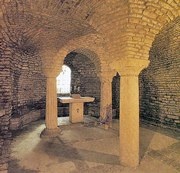

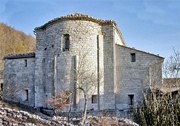
Early History
[The earliest surviving documentary reference to the abbey dates to 1030, when it owned San Damiano. By 1103, had passed into the ownership of a family from Assisi: ]
The earliest surviving document relating to a monastery of San Benedetto is in the archives of San Rufino and dates to 1041, although it is not clear whether that was San Benedetto al Monte Subasio or San Benedetto di Satriano. Both were recorded as possessions of the Abbazia di Farfa in an undated document written at the time of the election of Abbot Berardus I of Farfa (1048): however, neither appears in lists of possessions of Farfa after 1084. (San Benedetto di Satriano seems to have closed early in the 14th century. Its precise location is unknown.) The other secure reference to San Benedetto al Monte Subasio was in an inscription from San Paolo in Assisi, which recorded that Aginaldo, Abbot of San Benedetto al Monte Subasio founded the church and adjacent priory in 1071. (This inscription no longer survives, but it was recorded in the late 19th century).
The crypt of an earlier church was discovered during restoration work in 1945-52: scholars date it variously to the 8th or 10th century. The present church and its crypt seem to date to the 11th century. The oldest of the bells at San Rufino came from San Benedetto: its inscription bears the name of Bono da Pisa and the date 1287.
The abbey features in the legend of St Rufinus of Arce, which was published in 1654. It seems that Rufinus was a young cleric who was thrown into a well at Arce, at the foot of Monte Subasio when he refused to perjure himself in defence of a priest charged with bad behaviour. Monks from San Benedetto saw a light coming from the well and, when they investigated further, found the body. They retrieved it and built a tiny church on the site, San Rufino in Arce. The feast of this saint is recorded in the late 12th century, so these events must have occurred before that time.
13th Century
A long period of disputation between San Benedetto and the bishops of Assisi came to a head early in the 13th century:
-
✴in 1198, Pope Innocent III seems to have confirmed San Benedetto al Monte Subasio as one of the possessions of Bishop Guido I; while
-
✴in 1221, Pope Honorius III confirmed its independence.
(It has to be said that neither papal document can be securely identified).
San Benedetto certainly reached its peak of prosperity in the 13th century. It made two important donations
-
✴In 1207, Abbot Tebaldo tried to give the Portiuncula to St Francis, although he insisted on paying an annual rent of a basket of fish. (The Portiuncula remained formally a possession of San Benedetto until at least 1244).
-
✴In 1212, Abbot Maccabeo transferred the church of San Donato (which had been adapted from the Roman temple) to the newly-formed Commune for use as the Palazzo dei Consoli.
The church of SS Trinità outside Assisi belonged to the abbey in the early 13th century.
The Benedictine nuns of San Donato di Flebulle at Colcaprile, outside Assisi (who later moved to San Giacomo), were first documented in 1233, at which time it probably belonged to the San Benedetto. This probably accounts for a dispute with the bishop of Assisi, who imprisoned the Abbess Pacifica and appropriated some of the goods of the nunnery in ca. 1241. Pope Gregory IX and Pope Innocent IV intervened on behalf of the nuns, and the situation was resolved in their favour in 1243. However, the nunnery does not appear among the possessions of San Benedetto listed in a papal bull of 1244.
The abbey seems to have passed to the Cistercians in ca. 1260.
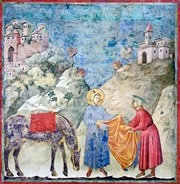
Later History
The fresco above shows the important strategic position of San Benedetto, and this was a major factor in its downfall in the civil disturbances of the 14th century. In 1380, the Commune installed its own custodian to ensure that the complex did nor fall into the hands of rebels or enemies. However, Ceccolino Michelotti succeeded in seizing it in 1399 and the small number of monks who still lived there fled to San Paolo. The Commune, which was then controlled by Broglia di Trino, attacked and partially destroyed the abbey, and it was subsequently abandoned. (The campanile, which can be seen in the fresco above, was never rebuilt).
The abbey passed in commendam to Bishop Corradini of Segni in 1405 and to Cardinal Antonio Caetani in 1409, a situation reflective of the contemporary papal schism. In ca. 1450, it passed to Cardinal Latino Orsini, who transferred to his nephew, Cosimo Orsini in 1453. Cardinal Orsini was much concerned with monastic reform. In 1468, he persuaded Pope Paul II to grant San Salvatore in Lauro in Rome (which he had had rebuilt and endowed) to the Congregation of Canons Secular of San Giorgio in Alga, a strict congregation that had been formed in the Pope’s native Venice. In the same letter, the Pope united San Benedetto al Subasio with San Giorgio in Alga. The canons financed a major restoration of the abbey in 1601 and retained its ownership until their suppression in 1652.
The abbey reverted to a series of commendatory abbots, the last of whom, Cardinal Antonio Pallotta, died in 1854. It then passed to the Congregazione di Propaganda Fide until 1860, when it was sold into private ownership. The abbey passed to the Abbazia di San Pietro in 1945. It was restored in 1945-52 and is currently again in restoration (January 2008).
Church (11th century)
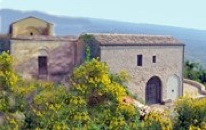
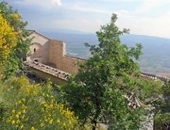
Despite its turbulent history, the apse of the church (illustrated above) and the lower part of its walls survive from the 11th century. Its facade retains the original portal, but is spoiled by a farm building to the right. Unfortunately, the structure remains open to the sky.
It has a very long nave and a raised presbytery over a crypt. The presbytery has a communicating chapel to the left, and a closed arch once connected it to a pendant chapel to the right.
Crypt (11th century)
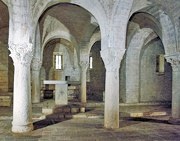
-
✴two to the sides of the altar in the apse,
-
✴four across the widest part of the crypt, and
-
✴two nearer to the back wall.
Crypt (10th century ?)
